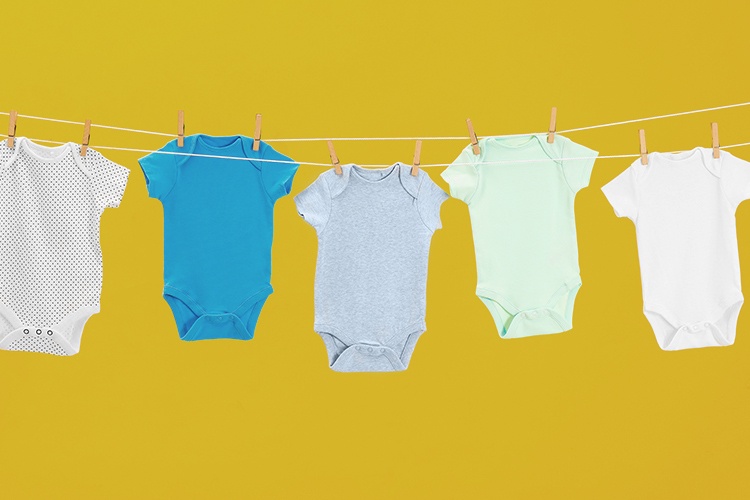Onesies are some of the most popular forms of baby wear and a favorite baby shower gift. There are even adult one-piece pajamas that look like large versions of these baby outfits. They have even become streetwear in the form of jumpsuits for men and women. If you are planning to buy one, however, remember that the name Onesies® is not generic. It’s a trademarked brand name for an infant bodysuit, and the trademark is owned by Gerber Childrenswear.

Popular and Practical
An Onesies® brand bodysuit is a soft, one-piece outfit that’s easy to put on any baby. Usually in a soft cotton fabric, it features short sleeves, a snap crotch and no legs.
Onesies® brand products became popular because they are comfortable for babies and make life easy for new parents. With no buttons, zippers or ties, they are safe for babies to wear, even while sleeping.
How did this simple garment become so popular that its name is often mistakenly used as a generic term for these bodysuits?
History of One-Piece Suits
Until the 18th century, most babies wore a simple cotton dress that buttoned loosely at the neck. This was standard wear for boys and girls. In fact, adults were the first to wear comfortable, one-piece suits.
In the 19th century, a clothing company in Utica, New York, began producing a one-piece suit in soft flannel it called a union suit. It was designed for women, and it was intended to replace the uncomfortable, constricting undergarments most women wore. The suit was a hit with women. It even appeared in the book Little Women, where it was called a “liberation suit.”
To capitalize on this popularity, the company soon adapted the design into a men’s version.
Check out more on common word and phrase trademarks.
Working Man’s Favorite
Over time, it was dropped by women, but the comfortable, lightweight men’s union suit became the most worn undergarment for working men and rural men. Traditionally made of red flannel, union suits later appeared in white and other pale colors. Westerns and older movies frequently show male characters taking off their clothes to reveal union suits underneath.
Other manufacturers soon adopted the style for a variety of outfits. Versions of the union suit included one-piece overalls in thick fabric, which were worn by workers who needed protective clothing, like railway workers and mechanics.
Siren Suit
During World War II, pilots wore one-piece suits known as flight suits or jump suits. Winston Churchill was fond of one-piece garments, which he wore frequently. After he was spotted wearing a protective one-piece suit during an air raid evacuation, the suit became known as a “siren suit.”
In the late 1940s, most men replaced union suit undergarments with two-piece “long johns.” At the same time, a man named Wiley Denton was working on a children’s version of the union suit.
Dr. Denton’s Sleepers
Denton worked for the Michigan Central Woolen Company, and his first design was a pair of pajamas with attached slippers. The company called it “Dr. Denton’s blanket sleeper,” even though Denton was not actually a doctor. The name was a pure marketing gimmick designed to make people think a doctor designed the sleepers.
The sleepers were an enormous success, and their success allowed Denton to establish his own company, the Dr. Denton Sleeping Garment Mills. Some people today still refer to footed pajamas as “Dr. Dentons.” The brand is so well known that the name Dr. Denton’s, originally a trademarked name, became generic.
How Trademarks Become Generic
Trademarks become “genericized” two ways. One, the trademark holder doesn’t act to protect the trademark by monitoring its use and taking legal action to stop people from using it illegally. Two, a court rules that a term has become so familiar to the public that it can no longer be considered a trademarked term.
Some words in common use that were once trademarks include aspirin, escalator, thermos and zipper. You can add Dr. Denton’s to the list.
The First Onesies® Brand Products
In the 1950s, a tailor named Walter Artzt invented a new version of the famous Dr. Denton design. He called it the Onesies® brand bodysuit. Sales of his baby suit soared, and Artzt established a successful company that sold Onesies® brand products and other baby items.
In 1982, the Gerber Company, which was famous for its baby food, purchased the company and renamed it Gerber Childrenswear LLC. It also secured trademark protection for the Onesies® brand name. Because of this legal protection, only Gerber’s items are authentic Onesies® brand products. Similar items from other manufacturers must be called bodysuits, snap suits, rompers, or one-pieces.
Protecting Its Trademark
Gerber Childrenswear LLC continues to vigorously protect the Onesies® trademark to prevent it from becoming genericized like “Dr. Denton’s” did decades ago.
On its official website, Gerber clearly states its position: “Gerber Childrenswear is proud of the outstanding name recognition of the Onesies® brand in the marketplace (95%) and will continue to be aggressive in protecting our trademark (U.S. federal trademark registration numbers 1,292,981, 2,549,557, and 3,488,401) in the market.”
The company has consistently enforced its trademark rights by issuing cease-and-desist letters to retailers and online marketplaces that improperly use the term “onesies” to advertise infant bodysuits not manufactured by Gerber.
Proper Usage of the Onesies® Trademark
According to Gerber Childrenswear’s official trademark guidelines, the Onesies® trademark should never be used as a generic descriptor or noun. Instead, it should only be used as an adjective followed by the appropriate generic term.
Correct usage examples:
- Onesies® brand bodysuits
- Onesies® brand products
- Onesies® brand clothing
The guidelines also specify that the ® registration symbol should appear after “Onesies®” and before the word “brand.” This consistent usage helps reinforce that Onesies® is a specific brand, not a generic term for any infant bodysuit.
Legal Enforcement Actions
In 2011, Gerber initiated legal action against clothing company California Christiana Republic over its “oneZ” branded infant bodysuit. Gerber asserted that this usage violated its trademark rights. The name, although spelled differently, was clearly pronounced like the famous Onesies® brand name. The lawsuit was settled, and the company discontinued use of the name.
In 2014, Etsy announced the closure of several stores on its platform that sold baby clothing. The closures came in response to a cease-and-desist letter from Gerber. The letter identified several sellers who were improperly using the word “Onesie” to advertise non-Gerber products. Gerber has taken similar enforcement actions against sellers on eBay and other online retailers to protect its valuable trademark.
Will the Onesies® Brand Avoid Genericide?
Onesies® brand products continue to be top sellers for Gerber Childrenswear LLC, even as many other companies produce similar one-piece bodysuits for babies. Gerber’s consistent and vigorous protection of its trademark demonstrates the company’s commitment to preventing the Onesies® brand name from becoming another casualty of genericide.
By educating consumers, retailers, and content creators about proper usage of the Onesies® trademark, Gerber Childrenswear LLC is working to ensure its valuable brand identity remains legally protected for decades to come.

